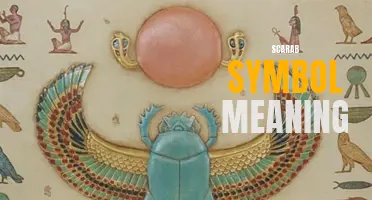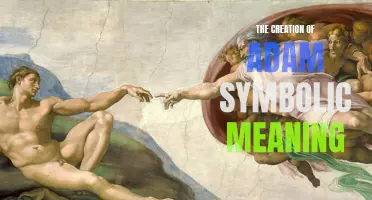
The St. Jude symbol holds both historical significance and profound meaning in various cultures and religious beliefs. Known as the patron saint of lost causes and desperate situations, St. Jude has become a symbol of hope, perseverance, and unwavering faith. From his iconic staff to his recognizable depiction with a medallion, the St. Jude symbol serves as a powerful reminder that even in the face of adversity, there is always light at the end of the tunnel. Join us on a journey to explore the deeper meaning behind the St. Jude symbol and discover why it continues to inspire and uplift millions of individuals worldwide.
What You'll Learn
- What is the meaning behind the St. Jude symbol?
- How does the St. Jude symbol compare to other religious symbols?
- What are some common interpretations of the St. Jude symbol?
- Are there any specific religious or cultural groups that use the St. Jude symbol?
- How has the meaning of the St. Jude symbol evolved over time?

What is the meaning behind the St. Jude symbol?
The St. Jude symbol is a powerful and meaningful representation of hope, faith, and resilience. St. Jude Thaddeus, also known as the Patron Saint of Hopeless Cases, is revered in the Catholic Church for his intercessory powers and miraculous healing abilities. The symbol associated with him serves as a source of inspiration and comfort for many.
The St. Jude symbol typically consists of an image of the saint himself, often portrayed as a bearded man holding a staff with a medallion or image of Jesus Christ. He is often depicted with a flame above his head, symbolizing the presence of the Holy Spirit. This flame is a reminder of the burning passion and unwavering faith that St. Jude possessed throughout his life.
The symbol also frequently includes the words "Saint Jude, Pray For Us" or variations thereof. These words serve as a call to seek the intercession and guidance of St. Jude in times of difficulty and despair. They affirm the belief that St. Jude is a powerful advocate, able to intercede on behalf of those facing seemingly impossible situations.
The St. Jude symbol is associated with hope because of the saint's reputation for helping those in desperate need. St. Jude is believed to have performed numerous miracles and offered hope to those who had lost all hope. His unwavering faith and trust in God's providence are seen as an example to individuals who are facing their own challenges and need a source of strength.
In addition to representing hope, the St. Jude symbol also signifies faith. St. Jude was one of the original twelve apostles chosen by Jesus Christ, and he remained steadfast in his faith, even in the face of immense hardship and persecution. The symbol serves as a reminder of the importance of nurturing and maintaining a strong faith, even during the most trying times.
Resilience is another theme associated with the St. Jude symbol. St. Jude's life was marked by perseverance and dedication to his mission. Despite facing countless obstacles, he continued to spread the message of Christ's love and offer hope to those who had lost faith. The symbol of St. Jude serves as a reminder to never give up, no matter how challenging the circumstances may appear.
The St. Jude symbol holds significant meaning for many individuals, particularly those facing difficult circumstances or seeking consolation in times of despair. It serves as a visual representation of hope, faith, and resilience, offering solace and inspiration to those who need it most. Whether worn as a medallion or displayed in a home or place of worship, the St. Jude symbol serves as a beacon of light in the darkest of times.
The Symbolic Meaning Behind the Fullmetal Alchemist Symbol
You may want to see also

How does the St. Jude symbol compare to other religious symbols?
The St. Jude symbol, also known as the St. Jude Medal or the St. Jude Thaddeus Medal, is a religious symbol associated with the Catholic Church. It is a representation of St. Jude Thaddeus, one of the twelve apostles of Jesus Christ. In Catholic tradition, St. Jude is often called upon as the patron saint of hopeless causes, and his symbol has become widely recognized and revered.
When comparing the St. Jude symbol to other religious symbols, it is important to consider the significance and symbolism behind each. Many religious symbols hold deep meaning for their respective faiths and are used as a representation of their beliefs and values.
One of the most widely recognized religious symbols is the Christian cross. The cross represents the crucifixion of Jesus Christ and is an essential symbol in Christianity. It is a symbol of sacrifice, redemption, and eternal life. The St. Jude symbol, on the other hand, specifically honors St. Jude Thaddeus and his intercession in desperate situations.
Another significant religious symbol is the Star of David, which is associated with Judaism. This six-pointed star is a representation of the Jewish people and their history. It holds religious and cultural significance, symbolizing the connection between God and the Jewish people. The St. Jude symbol differs from the Star of David in that it is specific to the Catholic tradition and focuses on the intercession of St. Jude.
In Islam, the crescent moon and star symbol is widely recognized as a representation of the faith. The crescent moon signifies the beginning and end of the Islamic month, and the star is associated with the Islamic prophet Muhammad. The St. Jude symbol is unique to the Catholic tradition and does not share direct similarities with the crescent moon and star symbol.
It is worth noting that while the St. Jude symbol is primarily associated with Catholicism, it can also be found in other Christian denominations. St. Jude Thaddeus is venerated in the Eastern Orthodox Church and is often depicted in iconography.
In conclusion, the St. Jude symbol holds great significance within the Catholic tradition, specifically honoring St. Jude Thaddeus and his intercession in desperate situations. When compared to other religious symbols, such as the Christian cross, the Star of David, and the crescent moon and star, the St. Jude symbol is unique to the Catholic faith and focuses on a specific aspect of belief and intercession. Each religious symbol carries its own deep symbolism and holds significance within its respective faith tradition.
The Deep and Symbolic Meaning Behind Rammstein's Iconic Symbol
You may want to see also

What are some common interpretations of the St. Jude symbol?
The St. Jude symbol is often associated with St. Jude Thaddeus, one of the twelve apostles of Jesus. St. Jude is known as the patron saint of desperate cases and lost causes, and his symbol has come to represent hope in the face of seemingly impossible situations. There are several common interpretations of the St. Jude symbol that people have embraced throughout history.
- Divine Intervention: Many people who wear or display the St. Jude symbol believe in the power of divine intervention. They see St. Jude as a source of miracles and turn to him for help when they feel overwhelmed or hopeless. The symbol becomes a reminder that there is always a glimmer of hope and a chance for a positive outcome, no matter how dire the circumstances may seem.
- Resilience and Strength: The St. Jude symbol is also often associated with resilience and strength. St. Jude is said to have endured many hardships and challenges during his life, but he remained steadfast in his faith. Those who identify with the symbol often draw inspiration from St. Jude's ability to persevere and find hope in the most difficult situations.
- Trusting in God's Plan: Another interpretation of the St. Jude symbol is that it represents a belief in God's plan. Those who wear or display the symbol may see it as a reminder to surrender control and trust that everything happens for a reason. They find solace in the idea that even when things don't go as planned, there is a higher purpose at play.
- A Beacon of Hope: The St. Jude symbol can also be seen as a beacon of hope for those who are struggling. It serves as a reminder that there are others who have experienced and overcome similar challenges, and it gives people the strength to keep going. The symbol can serve as a source of comfort and support, especially during difficult times.
- Community and Solidarity: Lastly, the St. Jude symbol can represent a sense of community and solidarity. Many people who wear or display the symbol feel connected to others who share the same beliefs and values. It serves as a unifying force, reminding people that they are not alone in their struggles and that there is a network of support available to them.
Overall, the St. Jude symbol carries various meanings for different individuals. Whether it represents divine intervention, resilience, trust, hope, or community, it serves as a powerful symbol of strength and encouragement for those facing difficult circumstances.
Unlocking the Hidden Meanings Behind Various Unalome Symbols
You may want to see also

Are there any specific religious or cultural groups that use the St. Jude symbol?
The symbol of St. Jude, also known as the patron saint of hopeless causes, is often associated with the Catholic Church. St. Jude Thaddeus, one of the twelve apostles, is revered as the saint who can intercede in situations that seem impossible or beyond human control. However, the use of the St. Jude symbol extends beyond Catholicism, as this revered saint has gained popularity in different religious and cultural groups.
One of the religious groups that use the St. Jude symbol is the Eastern Orthodox Church. In Eastern Orthodoxy, St. Jude is also recognized as a powerful intercessor who can help in times of deep despair and hopelessness. Orthodox Christians often display the image of St. Jude in their homes and churches, seeking his divine assistance and guidance.
Another religious group that venerates St. Jude is the Anglican Communion. Anglicans, who are part of the worldwide Anglican Church, often invoke St. Jude's intercession and offer prayers to seek his help in desperate situations. Many Anglican churches have dedicated altars or chapels to St. Jude, where the faithful can come and pray for his intercession.
Aside from religious groups, the St. Jude symbol is also embraced by various cultural and ethnic communities. For instance, in Latin American countries, St. Jude is widely venerated and considered a powerful advocate in times of need. The devotion to St. Jude is particularly strong in Mexico, where his feast day on October 28th is celebrated with processions, prayers, and offerings. In some neighborhoods, it is customary to light candles or leave small offerings at St. Jude shrines to seek his assistance.
Moreover, the St. Jude symbol has gained popularity in the African American community, where the saint is seen as a source of hope and inspiration. St. Jude is often invoked for help in overcoming adversity and finding strength during challenging times. As a result, St. Jude images and statues can often be found in African American households, churches, and community centers.
In conclusion, while the St. Jude symbol is primarily associated with the Catholic Church, its use extends beyond Catholicism. The Eastern Orthodox Church, Anglican Communion, and various cultural and ethnic communities also embrace St. Jude as a powerful intercessor in times of hopelessness. Whether one seeks his help in religious or cultural contexts, the symbol of St. Jude embodies a universal appeal for courage, faith, and perseverance in the face of seemingly impossible situations.
Decoding the Symbolism Behind Swords: Unveiling the Deeper Meaning
You may want to see also

How has the meaning of the St. Jude symbol evolved over time?
The St. Jude symbol, also known as the "St. Jude's image," has evolved over time to encompass a range of meanings and interpretations. Initially, the symbol was associated solely with the Catholic saint, St. Jude Thaddeus, known as the patron saint of lost causes. However, as time went on, the symbol began to take on additional layers of meaning and became a powerful symbol of hope, perseverance, and compassion.
In its early stages, the St. Jude symbol was primarily recognized as a religious symbol representing faith in the face of adversity. Saint Jude Thaddeus was one of the twelve apostles and was often depicted carrying a staff, which became a prominent feature in the symbol. The staff symbolized his role as a pilgrim, as well as his position as an apostle. The image of St. Jude holding the staff became a visual representation of his role in guiding and supporting people through difficult times.
As the symbol gained popularity, its meaning expanded beyond religious contexts. People began to view the St. Jude image as a powerful emblem of hope and perseverance, even outside the confines of religious beliefs. The idea of turning to St. Jude in times of despair, regardless of one's faith, became prevalent. The staff, which was originally associated with St. Jude's pilgrimage, came to represent the resilience and determination needed to overcome life's challenges.
Moreover, the symbol became synonymous with compassion and care for those in need. St. Jude Thaddeus was known for his acts of kindness and for his dedication to helping those who had nowhere else to turn. Consequently, the St. Jude symbol began to signify the importance of empathy and support for those who were marginalized or facing difficult circumstances. It became a reminder to extend a helping hand and offer compassion to others, especially those who were considered "lost causes."
In recent years, the St. Jude image further evolved with the establishment of the St. Jude Children's Research Hospital. The hospital, founded by entertainer Danny Thomas in 1962, specializes in pediatric treatment and research for children with catastrophic diseases. The St. Jude symbol became closely associated with the hospital and its mission, signifying the hope and healing it provides to young patients and their families. It has become a symbol of life-saving treatments, cutting-edge research, and ongoing efforts to find cures for childhood diseases.
Overall, the meaning of the St. Jude symbol has evolved from a religious emblem to a powerful representation of hope, perseverance, and compassion. It has grown to transcend religious boundaries and has become a universal symbol of support and care for those facing difficult challenges. Whether in the form of religious devotion, personal resilience, or charitable efforts, the St. Jude symbol reminds us of the importance of having faith, extending empathy, and never giving up in the face of adversity.
Decoding the Enigmatic Berber Symbols: Unraveling Their Deep Meanings
You may want to see also
Frequently asked questions
The St. Jude symbol is often associated with the Catholic saint, St. Jude Thaddeus. He is the patron saint of lost causes and desperate situations. The symbol represents hope, faith, and perseverance in the face of difficulty.
St. Jude is often associated with lost causes because of his reputation for interceding in impossible situations. He is believed to have the power to help those who have no one else to turn to. People often pray to him when they feel hopeless or when they are facing seemingly insurmountable challenges.
St. Jude was one of the twelve apostles chosen by Jesus. After Jesus' crucifixion, St. Jude traveled to spread the message of Christianity. He faced persecution and hardship throughout his mission, but remained steadfast in his faith. He is said to have performed miracles and healed the sick, which earned him the reputation as the patron saint of lost causes.
The St. Jude symbol is unique in its association with hope in desperate situations. While many religious symbols may represent different aspects of faith and spirituality, the St. Jude symbol specifically embodies the idea that even in the most challenging times, there is still hope.
The St. Jude symbol is primarily associated with Catholicism and Christianity, but anyone can use it as a symbol of hope and faith. It is not restricted to a specific religious group. Many people, regardless of their religious beliefs, may find solace and inspiration in the St. Jude symbol during difficult times.







